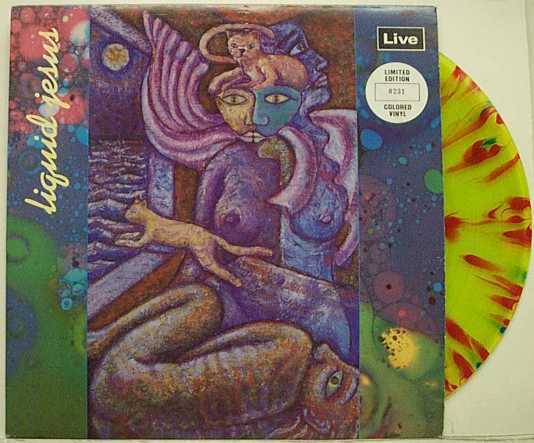Liquid Jesus: Live Review

Cover painting by Ron Liak
Even though I try to make informed, well thought out decisions as often as I can–sometimes I act on pure impulse. Sometimes I suffer the consequences of these actions, sometimes I embrace them. Buying Liquid Jesus: Live was my knee jerk response to its beautifully psychedelic album artwork, I had no idea what this album was like, and neither did any of the employees of the record store I purchased it at. Perplexed by the album I had taken home with me, I searched the band on Google only to find that Liquid Jesus was as much of an anomaly to the vinyl community as it was to myself. So only one question remains to be answered: is Liquid Jesus: Live any good?
Anyone familiar with 1960’s psychedelic rock will immediately notice the similarities between Liquid Jesus, and past masters like Led Zeppelin. Almost every song on this album focuses on driving guitar grooves, backed up by incredibly complex bass, and drum playing. Live’s opening track “Where Have You Been?” epitomizes the album’s song structure–it begins with an extended guitar solo that’s heavily distorted with whammy bar, and a myriad of synthesizers, which yields to the pulsating groove that the remainder of the song develops. A song’s groove typically remains largely the same throughout the track–lending both a sense of familiarity, as well as foundation to what would otherwise be a hopelessly confusing album. However, Top of the Wheel develops its groove into several distinct verses, and breakdowns, making its epic run time one of Live’s standout moments. Some tracks do deviate from their peer’s groovy psychedelia. “Slight Flight” is a brief bluegrass outro to side one, and “Dream Awhile” is an acoustic piece that contains the album’s best example of vocal harmonies.
The musicianship on display here is noteworthy as well. All of the guitar solos on this album are creative, and display a remarkable level of precision, and artistic control of the guitar–coming across as a more distorted take on Dave Gilmour’s expressive guitar solos on Pink Floyd’s 70s albums. Drumming is consistently top notch throughout Live’s runtime, switching between incredibly complex syncopated beats reminiscent of jazz, and steadier, albeit just as complex, patterns. Buck Murphy’s singing is well done, it combines both the drive of Robert Plant’s work with Led Zeppelin, and Geddy Lea’s sense of melody and structure. Even though it is often overlooked, the bass playing on Liquid Jesus: Live is outstanding. Live’s bass parts do not avoid the guitarist, playing simplified versions of his parts, they dive headlong into the chaos in an absurdly groovy display of technicality.
So, was Liquid Jesus: Live worth listening to? Absolutely. Any fan of classic rock would be doing themselves a disservice to not at least give this album a try. Live represents the longevity of great music. In spite of the fact that it sounds like it took place in the 60s, the concert being discussed here was given in 1990, long after Hendrix’s generation of performers. Basically, Liquid Jesus: Live is a testament to the validity of classic rock as just that.


